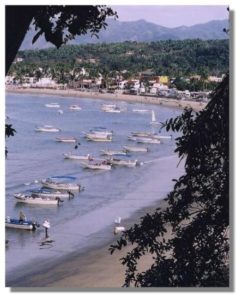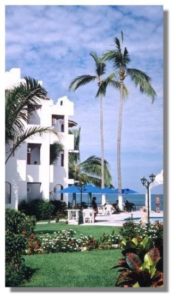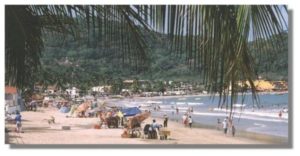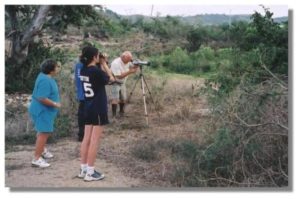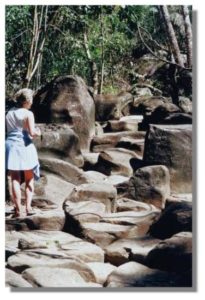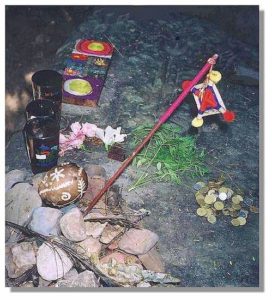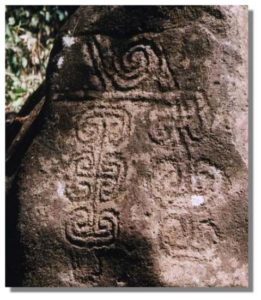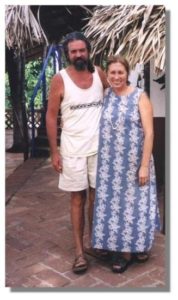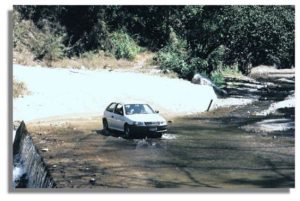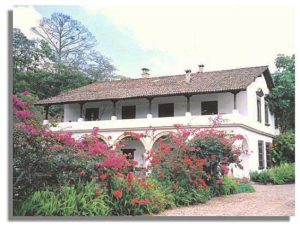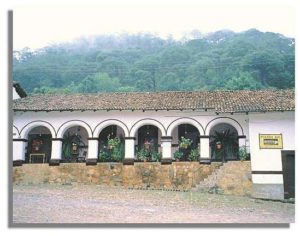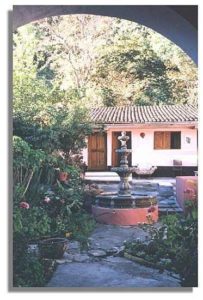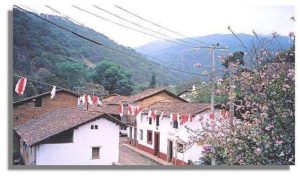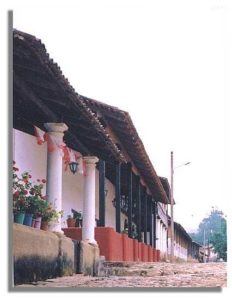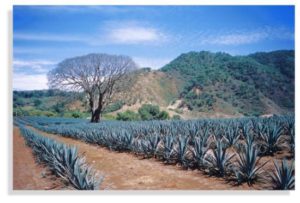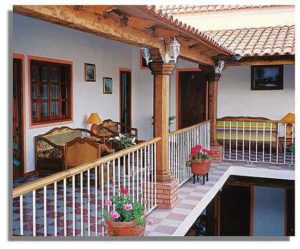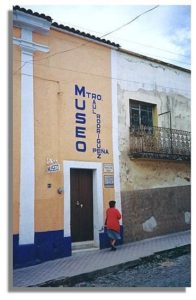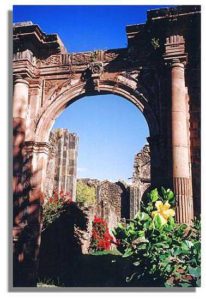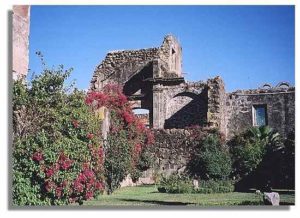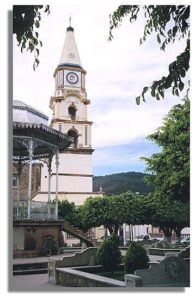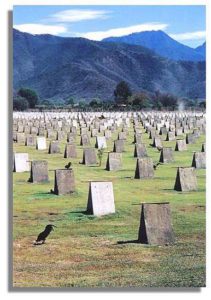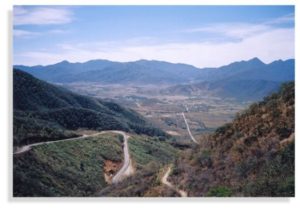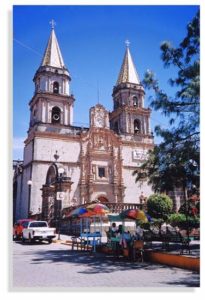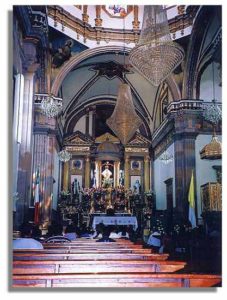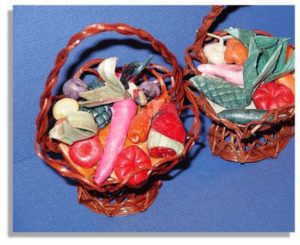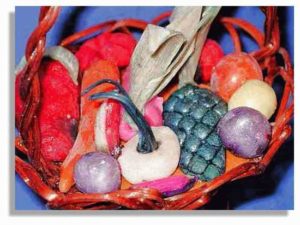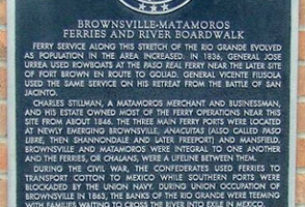The seat sale prices for flights to Puerto Vallarta were simply too good to pass up, and the weather at home too cold and miserable to buoy our spirits. Time for a short winter break in the sun!
Arriving in Puerto Vallarta in the mid-afternoon, we hired a small car at the airport and took off northwards to avoid the crowds and inflated prices of the big resort in favor of somewhere quieter.
Hotel Piedra Blanca
Less than an hour after landing, we were safely ensconced in a comfortable room at Hotel Piedra Blanca, with a golden sand beach beckoning us to venture beyond the large hotel pool. The Piedra Blanca is a short distance along the Punta de Mita road, which leaves the highway at a major intersection just beyond Bucerías, heading northwards from Puerto Vallarta.
We spent the next day enjoying some R’n’R and stocking up with some basic supplies for the adventure that had drawn us to the area – the drive up into the mountains to visit San Sebastián del Oeste and nearby towns.
The following morning, we had a quick explore of Cruz de Huanacaxtle and an excellent breakfast at Octopus Garden Café in the village at Coral 66. A companion craft gallery, Hikuri Impressions, has some attractive T-shirts, as well as many fine examples of Huichol Indian art. Items on the restaurant’s interesting menu are very fairly priced. Our hungry 12-year-old was soon attacking numerous tasty sopes (5 pesos each for beans and cheese, 7 pesos for meat), while our teenage daughter opted for French toast filled with cream cheese. We stocked up with “western eggs”, poached eggs enhanced with a subtle cream of cilantro sauce and accompanied by a meat patty.
Up into the mountains
Once the Western Eggs were out of the way, it was time to start the drive to San Sebastián del Oeste or “Western” San Sebastián! Drive back along the coastal highway (200) and across the Ameca river bridge. The river is the boundary between the states of Nayarit and Jalisco. Just south of the bridge, take the side road signed “Las Palmas”. The first part of this road is almost always congested with vehicles but the traffic thins out very rapidly after Las Palmas. Before leaving Las Palmas, check that you have four good tires, a spare, a full tank of gas and plenty of drinking water.
The three to four hour trip across the mountains is on a graded, but not paved, road. Some sections are single lane with pull-offs for passing. At any time of the year, several streams have to be forded. Unless your vehicle has high clearance and/or 4-wheel drive, it is therefore wise to attempt this route only during the dry season (November to April). Part-way up this road is the site of Canopy Adventure, a series of cables and boardwalks that take thrill-seeking naturalists high into the tree tops. Note that bookings for this must be made in Puerto Vallarta beforehand.
La Estancia
Beyond this, the road gets narrower and more winding though any hazards or discomfort on this bumpy road are more than compensated for by the spectacular scenery. There are few signs of “civilization” until, a couple of hours later, after climbing some harrowing switch-backs, you emerge into the village of La Estancia. In the middle of nowhere comes a 20 peso toll for road improvement! La Estancia marks decision time. Turning left, which we did, takes you to San Sebastián del Oeste. Turning right takes you to Mascota and Talpa. La Estancia is also as near to San Sebastián as the public minibuses go on their daily route from Puerto Vallarta to Mascota and Talpa. An impromptu shuttle service in trucks enables San Sebastián-bound passengers to complete their journeys.
Hacienda Jalisco
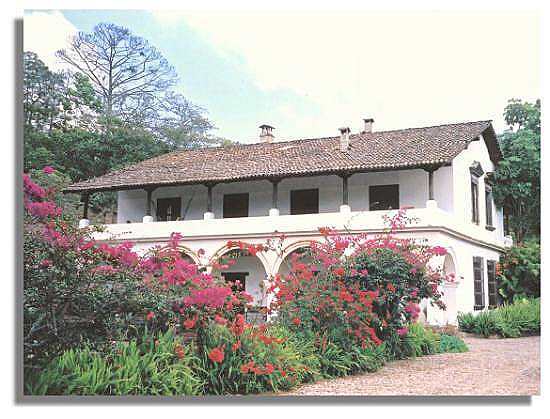
Two kilometers short of San Sebastián, and immediately before the newly-surfaced airstrip, a sign over a gateway proclaims “Hacienda Jalisco”. This fine old building is operated as a Bed and Breakfast by American owner Bud Accord, an ex-Hollywood type. Richard Burton and Elizabeth Taylor once stayed here. For overnight stays, reservations are essential. Assuming someone is home, even passing visitors can have an enjoyable hour or so being shown around the extensive property, in which every ancient wall has its tale to tell. “Museum visitors” are charged a modest ten pesos to wander amongst the fruit trees, stumble over remnants of the former mine workings (mainly for silver), and listen to stories of fabled wealth, replete with secret underground passages.
San Sebastián
An enterprising local artist transforms ore samples from abandoned mine workings, wrapping them in high denomination post-Revolutionary peso bills, to create unusual collectibles. The small art and craft gallery in the El Fortín restaurant in the center of San Sebastián is a good place to find them.
As we discovered, the El Fortín is also a very good place to eat. I can’t resist the temptation of “chicken in tamarind sauce”, but all our choices are well-prepared and attractively presented, if perhaps a tad over-priced. Before leaving, we buy a bottle of raicilla, a tequila-like drink made from the narrow-leafed lechugilla agave, to fortify us against the inevitable chill in the mountain air.
Like many a mountain town in Mexico, San Sebastián del Oeste, 1500 meters (5,000 feet) above sea level and founded in 1605, made a fortune from the gold, silver and copper deposits in its vicinity, before lapsing into quiet lassitude and ghost town status once the ore reserves were exhausted. The situation was not helped by a miners’ strike in 1888.
Salt used in the silver processing was brought on horseback over the mountains from a tiny primitive port called Puerto de las Peñas, at the mouth of the River Cuale, a port that later better known as Puerto Vallarta.
San Sebastián’s population dwindled from a high of several thousand in the nineteenth century to just 600 today. The town is coming back to life, however, as more and more tourists, charmed by its picturesque setting, tramp its cobblestone streets to discover the character-full nooks and crannies and marvel at its resurgence. In 2003, San Sebastián was formally proposed for membership of the exclusive list of UNESCO World Heritage sites.
The rejuvenation of the town has resulted in the small airstrip being paved for the first time. San Sebastián is advertised as a destination for jeep and horseback trips from Puerto Vallarta. Light aircraft (14-seater Cessnas) bring visitors daily from the coastal resort for lunch and a few hours exploring the town. Cost? Around 135 dollars a person. Far better to come for longer and stay a night or two in one of several small, inexpensive hotels.
We found rooms at the Posada del Sol, on the mountain side of the main plaza. The forest of plants in the Posada’s courtyard blend naturally into the forested hillside behind. The rooms are clean and simple; the people very friendly. As we arrived back to the hotel at dusk, just as the town settled down for the night under its blanket of evening mist, a young girl kindly offered us cups of hot chocolate and as many warm, freshly-baked cookies as we could eat.
There are several other options, including the Hotel El Puente, near the bridge. To find a restaurant, simply stroll the quaint, winding streets at mealtimes. We found the local restauranteurs to be very friendly and hospitable. One evening, for example, after we sat down, the kids decided (like the true Mexicans they are) that they wanted nothing more than “meat, beans and tortillas”. The restaurant owner immediately offered to divide a single order of carne tampiqueña and its trimmings into two for them, at no extra cost.
Compared with Puerto Vallarta, there is nothing to do in San Sebastián except peek into the neoclassic church (1886), the numerous small stores that sell everything you can think of, spend a few minutes in the local museum (Casa Museo de Doña Conchita Encarnación) and perhaps buy coffee from the coffee plantation on the edge of town. This is definitely a place where you make your own entertainment!
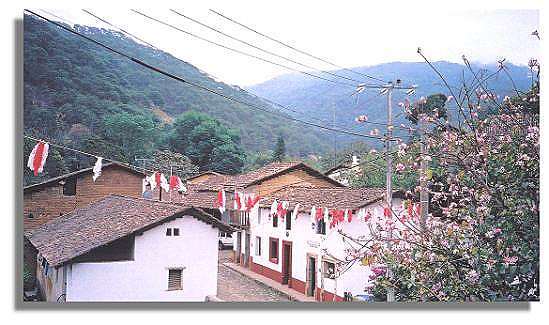
After unwinding in San Sebastián, we feel ready for the next leg of our exploration. This involves retracing our route back to La Estancia to take the unpaved “highway” to Mascota. From La Estancia, large fields of blue-green agave are soon left behind as the road serpentines its way through yet more forested mountains before descending onto the broad valley floor a few kilometers from Mascota. One large field houses hundreds of strange structures looking like miniature A-frames. It takes us several minutes to work out that this must be a farm breeding fighting cocks. Each bird is tethered to its own small shelter, affording it a degree of shade and protection. Fortunately, the tethers are not so long as to allow the birds to reach any of their neighbors…
Mascota
Moments later, we are entering Mascota, the “Emerald of the Mountains” (“Esmeralda de la sierra”). I was singularly unimpressed by the standard of the local hostelries on my first visit to Mascota some fifteen years ago, but things have really changed for the better since then. Today, the town boasts several exceptionally nice hotels, including El Mesón de San José and El Mesón de Santa Elena, which are virtually next door to each other on Calle Hidalgo.
The Mesón de Santa Elena is a member of the Haciendas y Casas Rurales de Jalisco, a network of select up-market inns helping to boost tourism to smaller towns and communities in the state of Jalisco. The Santa Elena has eleven rooms and two suites, with the original nineteenth century tile floors and old furnishings throughout. The building once belonged to Juan Robles Hurtado, the brother of José María Robles, whose statue is near the main church. The famous Robles is known as the “Martyr of the Cristeros War”, and was canonized in 2000 by Pope John Paul II. The inn has been beautifully remodeled in the best of tastes. One of the guest rooms even has its own fountain gurgling happily in a small private patio.
A few steps nearer the plaza is the Mesón de San José, beautifully appointed and more modern looking than the Santa Elena, but no less special. Friendly, easy-going service complements spacious rooms. If only we had another week’s vacation still to go!
As we saunter through the town after a milkshake and slice of cake at the small ultra-clean café on a street corner near the hotel, I’m amazed to discover a third fine hotel. The Mesón del Refugio occupies a building dating from 1847 on Calle Independencia. It is another member of Haciendas y Casas Rurales de Jalisco.
Even more amazing is the local post office. There is no service counter. Advice and stamps are dispensed from a desk outside the sorting room. The entire town of about 15,000 must be well served by daily deliveries since the Post Office has only 20 post boxes. The head postmaster kindly took time out from his regular duties and assembled a complete set of recently-issued special “Fauna” stamps for me from his stock. The whole experience was like walking back in time a century or two!
Besides whiling away some pleasant hours people-watching from a bench somewhere on the neatly-maintained plaza with its Ficus and orange trees (and lots of public phones), what else is there to do?
A few blocks north of the plaza, attractive gardens surround the evocative ruins of a massive church, begun in the eighteenth century but never completed. Most of the remainder of the town dates from the nineteenth century. The sold-looking stone buildings may look much older, but the original town was almost completely destroyed in December 1860 when a military commander named Antonio Rojas, “The Nero of Jalisco”, set fire to the town and razed it to the ground in a fit of pique.
A pair of interesting museums
The archaeology museum is well worth visiting. Fortunately, given the general lack of information in print, some of the exhibits more or less speak for themselves. A collection of petroglyphs from various localities, including Mascota, Talpa and Tomatlán, reveals, not surprisingly, the reverence attached by early people to the sun, water and fertility. From the Mesa del Durazno, near Mascota, comes a stone carved with the 52 spaces required for holding the five or six beans used in the game of Patolli. The oldest Patolli stones have been dated to between 300 and 600 A.D. by archaeologist Joseph Mountjoy, the undisputed authority on this area.
While seeking out petroglyphs, Mountjoy, together with a local farmer Juan José de la Torre, rescued loads of artifacts, which now form the basis of the museum collection. With funding from National Geographic, Mountjoy is now excavating a lakeside settlement (El Pantano) that dates from 800 B.C., pushing the archaeological record in this region back several hundred years. Work on a burial site has already suggested that the people held annual burial services, perhaps at the end of each dry season. The museum features some spectacular finds, including a rock crystal “gem”, believed to be some 2800 years old, and two dug-out canoes, 500 and 300 years old respectively.
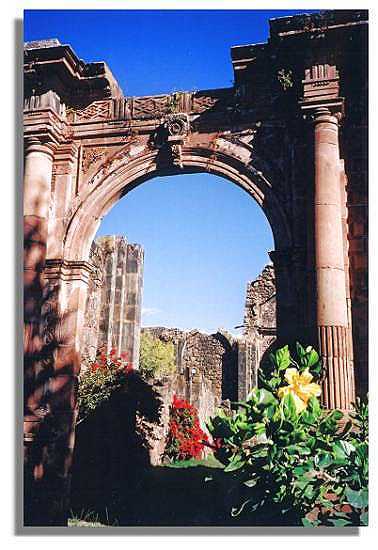
Around the corner, at Morelos 44, is the “Rodríguez Peña” Museum, which opened its doors in September 2000. This amazing eclectic collection was patiently assembled over 36 years by Raul Rodríguez Peña, who is always delighted to welcome visitors and give them a personal tour.
One room is devoted to Esther Fernández, a movie star born in Mascota. At age six, Fernández’s large family (she had 12 siblings) moved to Mexico City. By the age of 17, having already appeared in several films, including Corazones en derrota and Allá en el Rancho Grande, she was being given starring roles. During the Golden Age of Mexican cinema in the 1930s, she was the “most envied woman in the country”, acting regularly alongside the nation’s heart-throb: handsome blue-eyed charro singer Tito Guízar. By the time of her death, in 1999, she had amassed more than 60 movie credits. Photos and personal items document her considerable beauty, elegance and her illustrious career, which included three years in Hollywood with Paramount Pictures.
Other rooms in the museum are just as interesting. A fine collection of paintings by Gilberto Guerra González, a landscape artist, born in Mixtlán, hangs in one. Guerra González died in 1997; he is best known for his European-style representational landscapes. Another room is dedicated to the hero of the Cristeros war, José María Robles. Numerous other cabinets house European ceramics, typical kitchen pots and utensils, pre-Hispanic archaeological pieces…
Yerbabuena
By comparison, the Quinta Santa María “mini-museum” in La Yerbabuena, a few kilometers from Mascota by rough road, may be quaint and picturesque, but its very weird collection, praised in at least one guide book, is mainly comprised of old junk. Perhaps its value will be recognized by some future visiting team from Antiques Roadshow, but I seriously doubt it! Though parts of the road are rough, the drive beyond La Yerbabuena, to Cimarrón Chico and Navidad, is well worth it if only for the excellent views.
For the more adventurous, some hotels can also make arrangements for a picnic and water sports activities on a local reservoir.
From Mascota to Talpa
Years ago the horrible condition of the twenty-five kilometers of unmade road from Mascota to Talpa made driving it a very dusty and tedious experience. Now, however, the road is completely paved, saving both time and nerves. Climbing up out of Mascota, the views expand over the valley, revealing hitherto-unseen villages tucked away in the distance. The road then winds through the pine forest, with some attractive rock formations and many possible hiking or bird-watching spots.
La Cruz de Romero
Before long, the junction for Talpa appears. A few kilometers along this road is a chapel on the right-hand side and a large parking area. Pull off the road and climb the steps of La Cruz de Romero to admire a fantastic view over the town and valley far below. Despite its location on the floor of a valley, the name Talpa is supposed to mean “high place.” The original cross was erected by José Romero, a Talpa architect. When it needed to be replaced, on account of wear and tear due to the incessant kisses of passing pilgrims, thankful to have reached this promontory overlooking their destination, Romero’s nephew was equal to the task. Before driving off again, check your brakes since the descent to the town is by one of the steepest paved roads anywhere in Mexico.
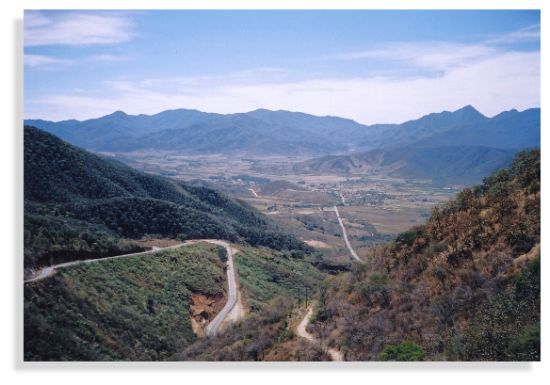
Talpa
As you explore the town it quickly becomes obvious that Talpa is a major religious center. The signs are everywhere, from the small stalls selling candles, prayer guides and rosaries to the shops which sell “everything for the pilgrim”, from the number of churches to the monumental statue of Christ the King which overlooks and protects the town. The only earthly reward for climbing up to the Cristo Rey is a great view!
Talpa has been a place of pilgrimage for several hundred years. The most venerated statue is that of Nuestra Señora del Rosario. Made of sugar-cane paste by a Tarascan Indian in Los Reyes, Michoacán in the 1530’s, it was brought to Talpa in 1585, fourteen years before the town was officially founded. In 1644 the statue, then housed in the San José church, one block from the main plaza, was in a poor state of repair and due for replacement. In a story echoed elsewhere in the country, as the statue was being taken down on the 19th of September, it suddenly emitted a bright light, dazzling all the onlookers present. When their sight returned, they discovered, to their amazement, that the Virgin was as good as new. This miracle was sufficient cause for the townspeople to erect a special sanctuary for the statue. The present sanctuary, a minor basilica, dates from 1755.
Talpa’s main fiesta runs from the 10th to the 19th of September each year. On the opening day, after a procession over a colorful, patterned carpet of sawdust and wildflowers, the Virgin is given a ceremonial wash and a change of clothes. For each of the next nine days the town echoes to the sounds of bells, firecrackers, music and merrymaking, the early morning mists look and smell like incense and the streets are littered with confetti. Other celebrations in Talpa include Candlemas (February 2nd), the Fair of San José (March 19th) and Día de Guadalupe (December 12th).
As you stroll through the narrow streets of Talpa, vendors, young and old but invariably friendly and polite, will try to persuade you to buy their guava-flavored candy, which you will see being made in huge copper vats in several local shops, or to purchase colorful and realistic-looking miniature sandals, sombreros, flowers and fruit baskets made of chilte, a local version of chicle, chewing gum. These look much too good to eat, but could be an unusual and inexpensive gift for someone back home. The Talpa region has long been renowned for its chicle; pre-Columbian Indians discovered that the sticky latex of the sapotaceous trees native to this area could be used to make hard, rubber-like balls.
As you pass, take a look inside Talpa’s town hall, which is a lovely colonial building dating from 1802. Inside, a mural by Santiago Rosas Zepeda depicts the defense of the plaza when the town was attacked by two hundred followers of Carranza, in the middle of the Mexican Revolution.
So much more than just a religious museum
For much of the nineteenth century, Talpa was an important gold and silver mining center. Numerous religious items, such as chalices, made of precious metals, can be admired in the Museo de Nuestra Señora del Rosario de Talpa, located behind the main church. The museum is open Tuesdays to Sundays from 9 A.M. to 3 P.M.; admission is 5 pesos a person, children under 12 enter free. Also among the exhibits are several fine chilte models, including a market stall laden with fruit and vegetables, a shrine, a Virgin and even an entire church! By comparison with these finely crafted older examples, the workmanship in the chilte figures now sold in the town is disappointingly crude.
It is also worth studying the interesting collection of retablos, naive votive paintings, usually done on tin, that are a means of saying thank-you for some favor received. Examples in this collection range from sick animals that recovered miraculously, to safe delivery from car wrecks, tree-chopping accidents, surgical procedures and, my favorite, from an ice-cream cart that overturned! Oh, the dangers of trying to buy a paleta!
Every trip has to end sometime
Giving silent thanks for a wonderful week exploring in the mountains, but regretting that we can’t spend more time in Talpa, we take our leave to begin the return drive back to Puerto Vallarta in order to catch the next day’s charter flight back home. If I pray really hard and promise to bring a suitable retablo with me next time, will there perhaps be a similar seat-sale every year?
How To Get There
Air: Several carriers offer charter flights (light aircraft only) from Puerto Vallarta to San Sebastián, Mascota and Talpa.
Road:
(A) From Puerto Vallarta
The route is described in the article. Caution: Only four-wheel drive or high clearance vehicles should use the road between Puerto Vallarta and San Sebastián during the rainy season (June to October). During the dry season, a regular passenger car can usually safely negotiate this route. Public minibus: advance purchase of tickets is essential, from Farmacia Provida, next to Parque Hidalgo, at the north end of the sea-walk (malecón). Buses depart from the park early each morning.
(B) From Guadalajara
Highway 70 (well paved all the way) branches off Highway 15 just west of Guadalajara, passing through Tala, Ameca, Mixtlán and Atenguillo en route to Mascota. Talpa is reached from a well-signed junction about 20 kilometers before Mascota. Guadalajara-Mascota and Guadalajara-Talpa are served by regular bus lines.
Where to Stay (prices, in pesos as of March 2003, are for two persons sharing a double room)
Playa Piedra Blanca
Hotel Piedra Blanca
Alcatraz #36, Esq. Playa, La Cruz de Huanacaxtle,
C.P. 63732, Nayarit.
Tel: (329) 295-5489
Fax: (329) 295-5493
Rate: $500
San Sebastián del Oeste
Hacienda Jalisco
Domicilio Conocido, San Sebastián del Oeste, via Mascota, Jalisco
Tel: (322) 297-0418 (messages only)
Rate: $800 (includes breakfast)
Posada del Sol
Lopéz Mateos 15,
San Sebastián del Oeste, via Mascota, Jalisco
Rate: $250
Mascota (85 km from Puerto Vallarta, 54 km from San Sebastián del Oeste, 25 km from Talpa)
Mesón de San José
Hidalgo 135, Mascota, Jalisco
Tel: (388) 386-1501
www.mesonsanjose.com.mx
([email protected])
Rate: $500
Mesón de Santa Elena
Hidalgo 155, Mascota, Jalisco
Tel: (388) 386-0313
([email protected])
Rate: $400
Mesón del Refugio
Calle Independencia 187, Mascota, Jalisco
Tel (388) 386-0767
([email protected])
Rate: $350 and up
Both the Mesón de Santa Elena and the Mesón del Refugio are affiliated to the Haciendas y Casas Rurales de Jalisco ([email protected])
Talpa
While we had no opportunity to stay there on this trip, very highly recommended is:
Hacienda Jacarandas
Apdo. Postal 25, Talpa de Allende
C.P. 48200 Jalisco
Tel: (388) 385-0317
Fax: (388) 385-0267
Rates: about $800 (includes breakfast)
Copyright 2004 by Tony Burton. All rights reserved.

